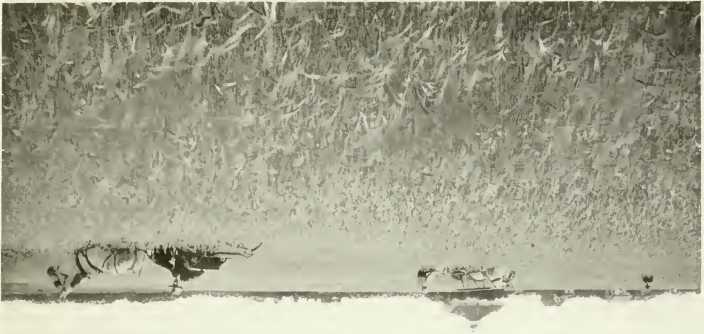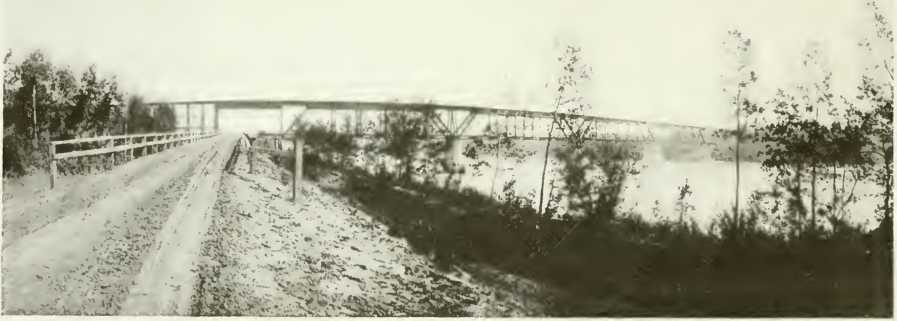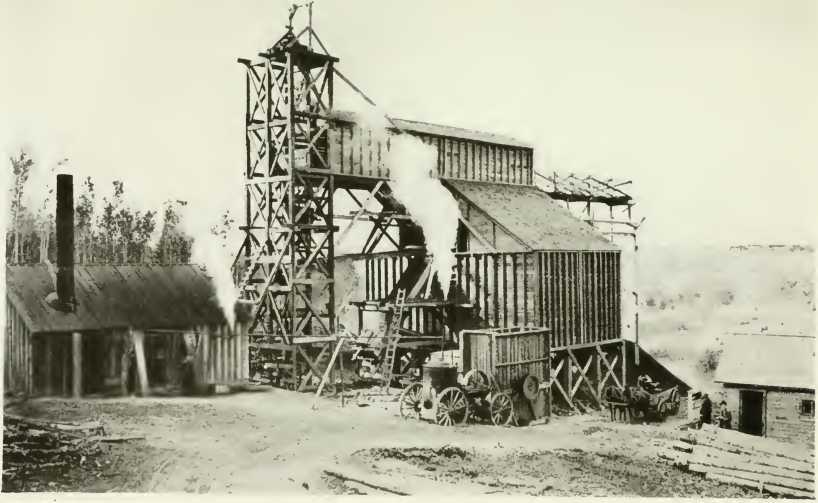|
The province of
Manitoba—The realization of “Sea Dreams”—Civic and agricultural
growth—Winnipeg—Railway enterprise—The Canadian Pacific and Grand Trunk
Railways —System of Government—Schools—Public Park—Prices of
produce—“Ralph Connor”—The Canadian Northern Railway —Winnipeg to
Edmonton—The chance of a millionaireship —Edmonton—The lady and the “
gentleman ” bus conductor— Colleges and schools—Churches and drinking
saloons— Vegetable products — Edmonton to Calgary — Flourishing
agriculture.
WHEN we think of the
years necessary to achieve the wealth and splendour of nations, and look
at the Province of Manitoba, it almost seems as if some good genius had
waved her wand, and lo, a barren lonely marsh and wild prairie are
suddenly changed, and golden harvest-fields, lowing cattle, model
dairies, comfortable homesteads and happy children rise as if by magic
before our eyes. We not unnaturally ask, “Whence came these?” and then
think of the city clerk’s vision in Tennyson’s “Sea Dreams,” of a woman
grown to enormous strength by “working in the mines,” and like him wake
to realize that honest toil—hard and matter-of-fact—is the secret of
collective as well as individual growth.

PRINCE ALBERT BRIDGE,
The wealth that lies in
the rich soil of this vast territory justifies the legend. Its output is
seen in prosperous cities and towns, rapidly spreading far and wide.
When Manitoba incorporated itself in the Confederation in 1870, it had
17,000 inhabitants, and now upwards of 400,000 English-speaking people
form its population. In 1870, its agricultural produce was not even
recorded. In 1881, an acreage of 51,300 yielded 1,000,000 bushels of
wheat, and 1,270,268 bushels of oats. In 1905, these odd millions jump
up to over 55,000,000.
Only 5,000,000 acres of
land are at present under cultivation, a patch compared with the actual
possibilities, as Manitoba is larger than Scotland, Wales and Ireland
combined, and contains 74,000 square miles of territory. Of this
30,000,000 acres are arable land.
Winnipeg is the seat of
the Government, and holds a foremost place amongst the cities of the
great continent. It is called The Gateway to the West. Its growth has
been extremely rapid, and it possesses all the modern conveniences of a
great centre. London has nothing to compare with its spacious streets,
and New York can scarcely out-do it in sky-scraping buildings. Electric
cars run in every direction, and public parks and promenades are
provided for the pastime and enjoyment of its thriving citizens. Its
thoroughfares are daily crowded with busy merchants, many of whom are
the descendants of the early Scotch colonists who reside in imposing
residences on the outskirts of the town. A walk in that direction shows
that Winnipeg, like all great cities, is cultivating suburban life.
New towns and villages
are quickly springing up, contiguous to agricultural and manufacturing
districts, and in the rapidity of their growth make Winnipeg the Chicago
of the Dominion.
The great incentive to
development has come from railway enterprise. The Canadian Pacific
running from east to west has many branches which bring settlers within
reach of rich agricultural soil, The Grand Trunk system, and the
Canadian Northern, each exploring different territory, have done much in
opening easy avenues for the transit of grain and stock to Winnipeg and
other important centres where traders find remunerative markets. Indeed,
one can see, in addition to provincial economic advantages, the
possibility of new routes by land and sea to and from and across the
Dominion through what is now a daily event—the extension of these great
railway systems.
Amongst other valuable
services rendered by the Government is the issue of reliable information
on trade and agriculture. There are annual returns from the Provincial
and Dominion Board of Trade which can be accepted as bona fide.
Emigrants and settlers are no longer the dupes of advertising agents and
others with axes to grind. The returns are too

good to need
embellishment or exaggeration, and any figures which are quoted here
have the imprimatur of the high authority to which I have referred.
The Government of
Manitoba is administered by a single Legislative Chamber, and executive
Council on practically an electoral basis of manhood suffrage. The
public school system is excellent, and entails the largest expenditure
in the annual budget. Public works come second, and the administration
of justice third. Schools are free to all children between the ages of
five and fifteen. In larger towns resident pupils are free to the high
schools and colleges. They are maintained largely by Government, who set
apart sections of land in each township which yield part of the revenue;
the rest is provided by a land tax. The growth of these schools is an
index to progress. In 1886, the number in the province was 422, with an
attendance of 16,834. In 1906 there were 1,847 schools and 64,123
scholars. Schools of agriculture are also provided, and associations for
instructing the settlers’ children in live stock, fruit growing, dairy
farming, and practically every branch of industry within the province
requiring skilled labour.
There is an excellent
tram service to the outskirts of the city, where there is a fine park,
containing zoological gardens which hold good specimens of bear, wapiti,
mountain goat, beaver and other animals. The Red River flows through the
park, on which motor boats and yachts were sailing. The wild features of
the place are preserved intact, and shady nooks and vistas of spreading
trees lend their charm. It was intensely hot, and seeking a cool retreat
I lay down and went fast asleep. A singular sensation awakened me, and
on opening my eyes I got a glimpse of a brown animal scuttling into the
grass, about the size of a gopher. He did not give me time to classify
him, but left a distinct impression on my face, over which he ran.
Commodities in Winnipeg
vary in price according to the supply ; apples very cheap ; oranges very
dear, 2\d. each ; plums of an inferior quality, 5d. a pound. On the
other hand, restaurants which almost jostle each other in the streets,
provide an excellent luncheon for ij. 3d. Hair cutting is a luxury ;
half a dollar, or 2s. 1d. in English currency, is charged for trimming
one’s beard, which had the effect on one forlorn traveller of making him
vow that henceforth he would become a Nazarene.
I spent a couple of
delightful hours with “Ralph Connor”—Rev. Charles W. Gordon—who, in
addition to his literary career, is a distinguished leader in the
Presbyterian Church. He has seen Winnipeg grow from the day of small
things, and watched men on the spot develop from obscurity into opulent
merchants.
I have alluded
elsewhere to his place in literature.

HEAVY CHOP, MANITOBA
He is an ardent
disciple of Isaac Walton, and as we had travelled over similar ground it
was pleasant to compare notes. He is saturated with the mystery and
grandeur of the Rocky Mountains, the full aroma of which pervades his
books. His influence in the higher walks of his profession has made him
the original of “The Sky Pilot” he has so well portrayed.
Singularly enough,
another leader in the religious life of Winnipeg is the Rev. J. L.
Gordon, with whom the novelist is often confused. The former, upon whom
I also called, narrated a number of cases of mistaken identity between
the minister and the author. The error is by no means uncomplimentary to
“Ralph Connor,” as his namesake is a strong personality and one of the
most popular preachers in Canada. Each has cut deeply in his own line,
and both possess a charming grace and simplicity.
A railway recently
constructed by the Canadian Northern runs from Winnipeg to Edmonton, a
distance of iooo miles. It traverses an undeveloped territory through
the provinces of Manitoba, Saskatchewan and Alberta. With the exception
of an occasional farm homestead between the stations, at which the train
stops, its course is through virgin soil.
The advent of the
railway gives an enhanced value to the adjoining land. It is the
philosopher’s stone, which turns base metal into gold, or, better still,
the wilderness into a fruitful plain. It affords facilities, for the
opening up of markets, the transportation of agricultural implements
which are absolutely indispensable in a region where labour is scarce at
best, and at times altogether unavailable. Without the railways, the
wealth of the prairies, as well as of forest and mine, is a locked-up
good, as unreachable as the gem of “ unfathomed caves of ocean.” Men may
buy the land, sell it, gamble in it, but it does not become a workable
asset until it is linked up with the towns and cities near and far. The
great waterways, valuable as they have been, can never become
substitutes as a means of transit. The method is slow, and if it affords
easy access to a district, it is in the same proportion difficult of
egress. A farmer may look at the golden grain and the smiling fruit, and
the fattening kine, and eat his heart out for the long-delayed
opportunity of exchange, which is the basis of all commerce.
The Canadian Northern
Railway, extending from Port Arthur to Edmonton via Winnipeg, has opened
up important territory. The effect was to be noticed in the activity at
every stopping-place along the line. There were houses newly erected,
and others in the course of construction. Barn-like structures
advertised themselves in large letters as hotels. Telephone wires
stretched from hut to hut, and agricultural implements, fearfully and
wonderfully made—at least to the lay mind—were piled near the stations.

Every platform was a
mart where farmers, agents, and speculators were there and then willing
to sell desirable sites and thriving farms. Judging from what I heard, I
might have been a millionaire, had I only the temerity, half a dozen
times over before reaching my destination. This spirit of
disinterestedness on the part of vendors has been checked of late years
by the formation of reliable bureaus under Government supervision. There
is no longer any necessity for a purchaser of land to find himself in
possession of a swamp, a by no means uncommon experience. The Prairie is
not a uniform El Dorado. It has its arid wastes, its thin substratum of
fertility, as well as its deep rich loam, and there hover over it all,
hawks which are ready to pluck any unwary bird about to stretch its
speculative wings.
The journey to Edmonton
is in itself an object lesson in inequalities. Great rivers are crossed,
cutting their sinuous way through vast plains, pregnant with the highest
possibilities of agriculture. Rocky soil comes into view of a different
order and more limited in productive qualities; lakes with great
stretches of marsh, out of which flocks of wild duck rise, attesting its
suitability for their habitat and little more.
It was late when we
arrived at Edmonton, the capital town of Alberta. A number of omnibuses
were drawn up at the station for the convenience of passengers. Choosing
that more archaic method of travel rather than the electric trams, I
found myself in company with half a dozen others, rattling over the
worst roads possible to imagine. The outskirts of Edmonton, like most
new Western cities, have to wait on their betters. The broad well-kept
streets in the town have had undue attention paid to them, to the
neglect of more remote thoroughfares. The bus stopped at various hotels,
the conductor arranging to deposit his passengers in the order which
suited his own convenience sooner than theirs. He took me a couple of
miles out of the way sooner than go round the corner at an earlier
stage. The reason was obvious—my hotel happened to be in the district
where the horses were stabled, and he left that for the last.
He had several passages
of arms with his fares, to which I listened with interest, as showing
the high point and fine shading that labour had reached in the Dominion.
Like everything else, it has the defect of its virtues.
“You must get down
here,” he said to a lady burdened with parcels and a valise; “the horses
can’t go up the hill.” The lady looked up with surprise, and replied
with great politeness, “A hill! There is no hill, gentleman! This is
So-and-so Street. I have parcels, gentleman, and it’s late.”
The “gentleman,”
nonplussed at this display of topographical erudition, banged the door,
and the omnibus went on.

RAILWAY AND TRAFFIC BRIDGE, SASKATCHEWAN
It was close on
midnight when I reached my destination. Rate of travel, three miles in
two hours!
Edmonton is situated on
the Saskatchewan River, well raised above its banks, and commanding an
imposing view. The population is nearly 25,000, almost double the total
of the 1906 census. It is the seat of government and the official place
of residence of the Lieutenant-Governor. The Alberta College has its
headquarters there, with 400 students attached. The educational system
is admirable. Large elementary schools have sprung up in a few years,
and a high school for advanced knowledge and university preparation. The
property is valued at over £100,000; all public requisites—water,
electric light, telephones and tramways — are municipalized. The system
of taxation makes no distinction between prairie land and land built
upon. A vacant lot is assessed at exactly the same valuation as one with
a five-storied building or factory on it. There is also a business tax
determined by floor space and nature of the industry.
There are twenty-four
churches, and twenty-one drinking saloons. The Secretary of the Board of
Trade, in commenting on this, said: “Churches are allowed an unlimited
margin of growth, but drinking saloons cannot be increased.” The
proportion in some of the provinces is one to a thousand of population.
The evidence of a great
coal industry is at once noticed on reaching Edmonton, in the blackened
track near the station, the elevated railway with its sidings, and the
inevitable row of coal wagons. The discovery of this mineral, which is
said to be a high-grade lignite, places the city in a unique position in
relation to the Dominion. So far it holds the monopoly of the trade. The
report of Government experts puts the area of the coal-bed at 11,000
square miles, and the quantity at 60,000,000 tons. The value of the find
to the inhabitants is most important, as the fuel can be purchased at
13½. per ton delivered, or ys. at the pit mouth.
Over 25,000 tons per
week are transmitted on the Canadian Northern Railway from the
Morinville mines, and the companies’ projected extension is planned to
traverse the Brazeau River valley, where further vast deposits of coal
have been discovered and only await railway facilities to become a cheap
and marketable commodity.
At the Board of Trade
offices I saw samples of various agricultural products, grown in
different parts of the province, which showed the versatility and
richness of the soil.
From Edmonton to
Calgary is another section of the Canadian Pacific Railway. It has been
opened up long enough for agricultural interests to take more definite
shape. Near Edmonton well-tilled farms are to be seen and herds of
cattle browsing on

A COAL MINE AT EDMONTON
the pasture. It is a
section of the prairie, the severe flatness of which is broken by
undulating hills.
Flax is cultivated in
large quantities, which is used in the manufacture of oil cake and
ropes.
The ground was being
broken up for the winter wheat as I travelled along the line, and from
the train we could see the steam ploughs busy at work. The grain is
threshed in the field where it is reaped, and the straw in that locality
is burned, as it finds no market. In other parts of the agricultural
districts it has an economic use, and commands a good price. |
